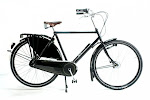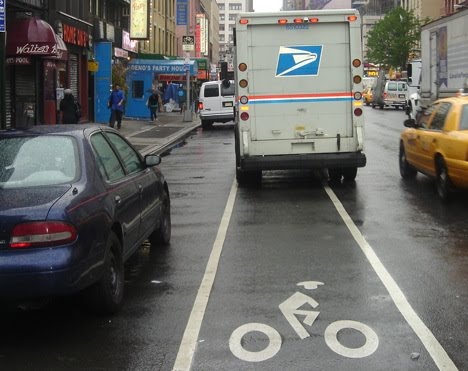Signed on March 11, 2010 and announced March 15, 2010
Note: Also available on the United States Department of Transportation WebsitePurpose
The United States Department of Transportation (DOT) is providing this Policy Statement to reflect the Department’s support for the development of fully integrated active transportation networks. The establishment of well-connected walking and bicycling networks is an important component for livable communities, and their design should be a part of Federal-aid project developments. Walking and bicycling foster safer, more livable, family-friendly communities; promote physical activity and health; and reduce vehicle emissions and fuel use. Legislation and regulations exist that require inclusion of bicycle and pedestrian policies and projects into transportation plans and project development. Accordingly, transportation agencies should plan, fund, and implement improvements to their walking and bicycling networks, including linkages to transit. In addition, DOT encourages transportation agencies to go beyond the minimum requirements, and proactively provide convenient, safe, and context-sensitive facilities that foster increased use by bicyclists and pedestrians of all ages and abilities, and utilize universal design characteristics when appropriate. Transportation programs and facilities should accommodate people of all ages and abilities, including people too young to drive, people who cannot drive, and people who choose not to drive.Policy Statement
The DOT policy is to incorporate safe and convenient walking and bicycling facilities into transportation projects. Every transportation agency, including DOT, has the responsibility to improve conditions and opportunities for walking and bicycling and to integrate walking and bicycling into their transportation systems. Because of the numerous individual and community benefits that walking and bicycling provide — including health, safety, environmental, transportation, and quality of life — transportation agencies are encouraged to go beyond minimum standards to provide safe and convenient facilities for these modes.Authority
This policy is based on various sections in the United States Code (U.S.C.) and the Code of Federal Regulations (CFR) in Title 23—Highways, Title 49—Transportation, and Title 42—The Public Health and Welfare. These sections, provided in the Appendix, describe how bicyclists and pedestrians of all abilities should be involved throughout the planning process, should not be adversely affected by other transportation projects, and should be able to track annual obligations and expenditures on nonmotorized transportation facilities.Recommended Actions
The DOT encourages States, local governments, professional associations, community organizations, public transportation agencies, and other government agencies, to adopt similar policy statements on bicycle and pedestrian accommodation as an indication of their commitment to accommodating bicyclists and pedestrians as an integral element of the transportation system. In support of this commitment, transportation agencies and local communities should go beyond minimum design standards and requirements to create safe, attractive, sustainable, accessible, and convenient bicycling and walking networks. Such actions should include:- Considering walking and bicycling as equals with other transportation modes: The primary goal of a transportation system is to safely and efficiently move people and goods. Walking and bicycling are efficient transportation modes for most short trips and, where convenient intermodal systems exist, these nonmotorized trips can easily be linked with transit to significantly increase trip distance. Because of the benefits they provide, transportation agencies should give the same priority to walking and bicycling as is given to other transportation modes. Walking and bicycling should not be an afterthought in roadway design.
- Ensuring that there are transportation choices for people of all ages and abilities, especially children: Pedestrian and bicycle facilities should meet accessibility requirements and provide safe, convenient, and interconnected transportation networks. For example, children should have safe and convenient options for walking or bicycling to school and parks. People who cannot or prefer not to drive should have safe and efficient transportation choices.
- Going beyond minimum design standards: Transportation agencies are encouraged, when possible, to avoid designing walking and bicycling facilities to the minimum standards. For example, shared-use paths that have been designed to minimum width requirements will need retrofits as more people use them. It is more effective to plan for increased usage than to retrofit an older facility. Planning projects for the long-term should anticipate likely future demand for bicycling and walking facilities and not preclude the provision of future improvements.
- Integrating bicycle and pedestrian accommodation on new, rehabilitated, and limited-access bridges: DOT encourages bicycle and pedestrian accommodation on bridge projects including facilities on limited-access bridges with connections to streets or paths.
- Collecting data on walking and biking trips: The best way to improve transportation networks for any mode is to collect and analyze trip data to optimize investments. Walking and bicycling trip data for many communities are lacking. This data gap can be overcome by establishing routine collection of nonmotorized trip information. Communities that routinely collect walking and bicycling data are able to track trends and prioritize investments to ensure the success of new facilities. These data are also valuable in linking walking and bicycling with transit.
- Setting mode share targets for walking and bicycling and tracking them over time: A byproduct of improved data collection is that communities can establish targets for increasing the percentage of trips made by walking and bicycling.
- Removing snow from sidewalks and shared-use paths: Current maintenance provisions require pedestrian facilities built with Federal funds to be maintained in the same manner as other roadway assets. State Agencies have generally established levels of service on various routes especially as related to snow and ice events.
- Improving nonmotorized facilities during maintenance projects: Many transportation agencies spend most of their transportation funding on maintenance rather than on constructing new facilities. Transportation agencies should find ways to make facility improvements for pedestrians and bicyclists during resurfacing and other maintenance projects.
Conclusion
Increased commitment to and investment in bicycle facilities and walking networks can help meet goals for cleaner, healthier air; less congested roadways; and more livable, safe, cost-efficient communities. Walking and bicycling provide low-cost mobility options that place fewer demands on local roads and highways. DOT recognizes that safe and convenient walking and bicycling facilities may look different depending on the context — appropriate facilities in a rural community may be different from a dense, urban area. However, regardless of regional, climate, and population density differences, it is important that pedestrian and bicycle facilities be integrated into transportation systems. While DOT leads the effort to provide safe and convenient accommodations for pedestrians and bicyclists, success will ultimately depend on transportation agencies across the country embracing and implementing this policy.Ray LaHood, United States Secretary of Transportation



